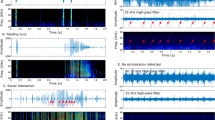Summary
-
1.
Under laboratory conditions echolocation sounds were recorded from four Megaderma lyra catching a mouse in complete darkness from an experimental table. Flight paths and sequences of sound emission were synchronously recorded by stroboscopic photography and high-speed tape-recording (Figs. 1 and 2).
-
2.
During approach toward a live mouse in 54% of 35 completely recorded flights, the bat emitted ultrasounds, but only up to five sounds could be recorded during a complete approach (Fig. 1a). During the other 46% of the 35 flights, the bat did not emit a sound, yet successfully caught the prey (Fig. 1 b).
-
3.
When a dead mouse was offered, only one bat successfully echolocated the dead mouse and emitted a specific double sound sequence of intense ultrasounds. The other three bats did not take off for an approach. When mouse noises were substituted for the live mouse, the approach flight of two of the bats was immediately triggered as if a live mouse were offered. Only a few echolocation sounds were emitted in both cases.
-
4.
It is concluded that M. lyra can locate the noise of live prey in complete darkness, without the use of echolocation.
Similar content being viewed by others
References
Airapetjantz, E. Sh., Konstantinov, A. I.: Echolocation in nature. Leningrad: Nauka 1970 (2nd ed. 1974)
Ehret, G.: Development of absolute auditory thresholds in the house mouse (Mus musculus). J. Am. Audiol. Soc. 1, 179–184 (1976)
Fenton, M.B., Morris, G.K.: Opportunistic feeding by desert bats (Myotis ssp.). Can J. Zool. 54, 526–528 (1976)
Griffin, D.R., Simmons, J.A.: Echolocation of insects by horseshoe bats. Nature 250, 731–732 (1974)
Griffin, D.R., Webster, F.A., Michael C.R.: The echolocation of flying insects by bats. Anim. Behav. 8, 141–154 (1960)
Habersetzer, J.: Ortungslaute der Mausohrfledermäuse (Myotis myotis) in verschiedenen Ortungssituationene. Diplomarbeit, Fachbereich Biologie, Universität Frankfurt (1978)
Kolb, A.: Sinnesleistungen einheimischer Fledermäuse bei der Nahrungssuche und Nahrungsauswahl auf dem Boden und in der Luft. Z. Vergl. Physiol. 44, 550–564 (1961)
Konishi, M.: How the owl tracks its prey. Am. Sci. 61, 414–424 (1973)
Möhres, F.P., Neuweiler, G.: Die Ultraschallorientierung der Großblatt-Fledermäuse (Chiroptera-Megadermatidae). Z. Vergl. Physiol. 53, 195–227 (1966)
Novick, A.: Pulse duration in the echolocation of insects by the bat, Pteronotus. Ergeb. Biol. 26, 21–26 (1963)
Novick, A.: Echolocation of flying insects by the bat, Chiloycteris psilotis. Biol. Bull. 128, 297–314 (1965)
Novick, A., Vaisnys, J.R.: Echolocation of flying insects by the bat, Chilonycteris parnellii. Biol. Bull. 127, 478–488 (1964)
Payne, R.S.: Acoustic location of prey by barn owls (Tyto alba). J. Exp. Biol. 54, 535–573 (1971)
Author information
Authors and Affiliations
Rights and permissions
About this article
Cite this article
Fiedler, J. Prey catching with and without echolocation in the Indian false vampire (Megaderma lyra). Behav Ecol Sociobiol 6, 155–160 (1979). https://doi.org/10.1007/BF00292562
Received:
Accepted:
Issue Date:
DOI: https://doi.org/10.1007/BF00292562




